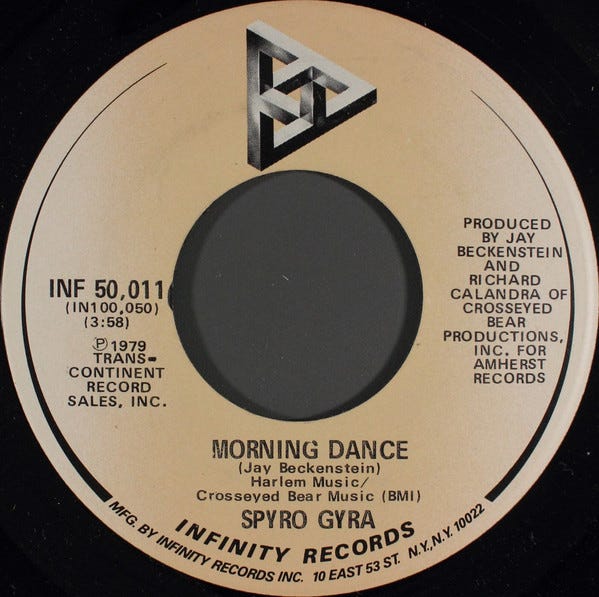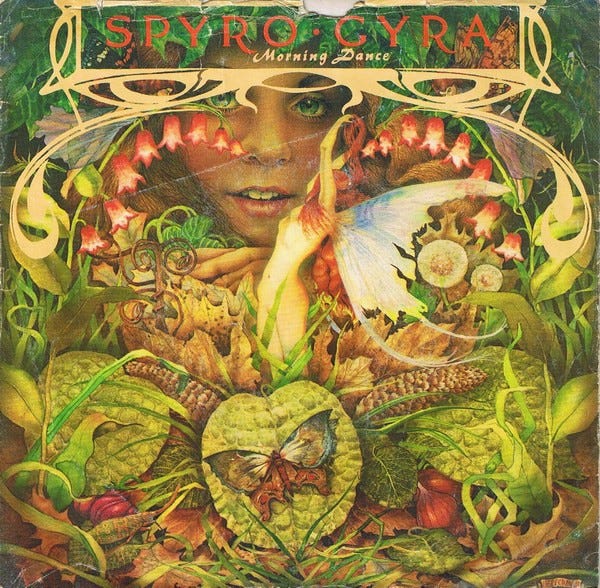Jazz Fusion and Head Lice
Spyro Gyra - "Morning Dance" (1979)
Greetings, Jagged Time Lapsers!
As I mentioned back when I launched this thing, one of my intentions with Jagged Time Lapse is to share chapters from my musical-memoir-in-progress with this Substack’s paid subscribers as I kick them into shape. (Kick the chapters, that is — not my subscribers.)
I don’t yet have a working title for the book, but the concept is similar to what my friend and colleague Josh Wilker did with his wonderful Cardboard Gods. Except where Josh used baseball cards from the 1970s as a means to make sense of his past, I’m using 45 rpm singles as a series of windows into my turbulent adolescence — a period of my life which coincided with some of the greatest music ever heard on AM (and FM) radio, as well as some of the absolute worst.
All the previous chapters I’ve written for the book — like the one about why a Jimmy Buffett 45 was one of the first singles I ever bought, or the one about how cheap steak, acid casualties and Silver Convention are irrevocably fused in my memories with The Guns of Navarone, or the one about how the film Grease mirrored my hellish entry to junior high — can be found in the Jagged Time Lapse archive, which also contains a ton of free reads on a wide variety of musical subjects.
If you’d like to read these posts in full (and have full access to the JTL archive) you can do it for just five bucks a month, or $50 a year… which I think is a pretty fair exchange for all the the quality content that’s already in the vaults, as well as all the tasty treats I have up my sleeve for the future. Plus, a paid subscription gets you full access to the monthly CROSSED CHANNELS podcast I’m doing with my friend and colleague Tony Fletcher. You can listen to a preview of our fifth episode below — our sixth will be along shortly!
So if that sounds like your kind of jam, please consider supporting my work by signing up for a paid Jagged Time Lapse subscription. (And if you already have a paid JTL subscription but cannot access this post beyond the paywall, PLEASE double-check to make sure that your credit/debit card hasn’t expired or otherwise requires updating.)
All righty then. So much for the sales pitch — let’s get on with the show!
“Hey, what’s that?” a soft-spoken adult male voice inquired, as a spritely yet smooth instrumental track chirped away in the background.
“That’s ‘Morning Dance’ by Spyro Gyra,” answered another adult male voice, equally soft-spoken but with a lower, more authoritative register. “Nice, isn’t it?”
“Oooh, yeah,” softly replied adult male voice number one, as if his mind had just been ever-so-slightly blown, but his intrinsic mellowness kept him from being overly demonstrative about it.
I heard this same conversation over and over again in the May of 1979. It was part of a radio ad for “Morning Dance,” the new single by Spyro Gyra, as well as the album of the same name that it had sprung from. I had never heard of Spyro Gyra before, nor had I had any prior contact with their particular brand of lightweight late-seventies jazz fusion, a precursor of the “smooth jazz” that would flower (or, depending on your outlook, metastasize) in the coming decade. But I couldn’t miss the tone of the radio ad, which suggested that this was exquisitely tasty music for mature sophisticates — and that if you desired to be and/or be regarded as a mature sophisticate yourself, then you should run right out and pick up the new Spyro Gyra LP.
Yes, it sounds utterly unimaginable now, but there was indeed a time when jazz fusion instrumentals were not only advertised on AM radio, but would actually hit the upper reaches of the American pop singles charts on occasion. In June 1978, Chuck Mangione had made it to #4 on the Billboard Hot 100 with “Feels So Good,” and Herb Alpert would go all the way to Number One in October 1979 with “Rise”. “Morning Dance” wasn’t anywhere near as massive or omnipresent as those two singles — its melody, played on the alto sax by Spyro Gyra co-founder Jay Beckenstein, wasn’t nearly as memorable, even if the track’s lilting steel drums were exceedingly pleasant — but it was nonetheless a genuine pop radio hit, eventually reaching #24 on the Hot 100 in the summer of ‘79.
Spyro Gyra was not in my musical wheelhouse at all, unlike Cheap Trick at Budokan, another record that was getting a big advertising push on L.A. radio stations like KHJ and KFI that spring. But while I loved the slam-bang hookiness of Cheap Trick’s music, Budokan’s radio ad — which featured a couple of voice actors doing a “Charlie Chan and Number One Son” routine (because hey, Chinese and Japanese is pretty much the same thing, right?) — was so embarrassingly racist that even 13 year-old me was completely turned off by it. Cheap Trick’s marketing clearly wasn’t being aimed at someone like me, someone who wanted to be taken seriously as a person of intelligence and taste. On the other hand, the message of Spyro Gyra’s ad spoke to me (“Hey, you’re a smart kid! Dig this!), even if the music didn’t. Maybe I actually needed some Spyro Gyra in my life?




